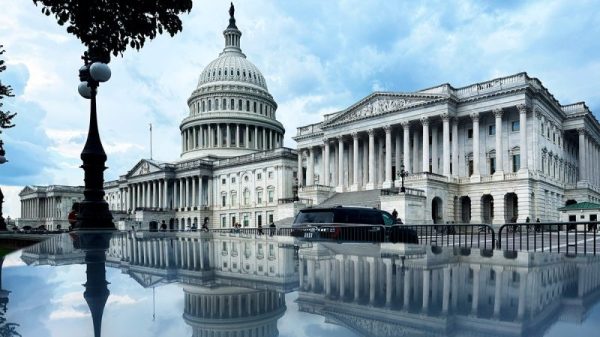Wisconsin is one of the most deeply politically divided states in the country. That’s reflected most obviously in the state’s presidential voting; the margin for the winning candidate has been fewer than 25,000 votes in four of the last six elections. In the past two, it was central to determining the winner of the electoral vote.
Yet, over that same period, the state legislature has been solidly Republican. In September, we explored the pattern in voting for the state Assembly and Senate in the past four cycles, finding that Republicans have consistently wound up with a higher percentage of seats in each chamber than they have in the statewide vote for their party’s candidates.
We can visualize that disparity. The outer ring of each circle below shows the percentage of the statewide vote going to each party’s candidates. The inner circle shows the resulting distribution of seats.
Most notable is the difference between 2016 and 2018 in the Assembly. In 2016, Republicans won 52 percent of the statewide vote and 64 of 99 seats in the Assembly. Two years later, Republicans won only 45 percent of the vote — but still ended up with 63 Assembly seats.
The occasion for our exploring this data last year was the election of Janet Protasiewicz to the state Supreme Court. Protasiewicz, a liberal jurist, won a surprisingly easy contest, giving liberals a majority on the court. That meant it was very likely that the gerrymandered legislative boundaries that had given Republicans the bulwark shown above were at risk; Protasiewicz had (controversially) spoken out against the existing lines before the election.
As was predicted, the existing districts were thrown out. On Tuesday, replacement maps proposed by Gov. Tony Evers (D) were approved by the Republican majorities in both chambers of the state legislature. It was a concession born not of enthusiasm about Evers’s proposal but, instead, out of fear about even less favorable maps that might be created by the court.
The speaker of the state assembly, Robin Vos (R), reluctantly told reporters that Evers had “a huge win today.” Why? Because, with the new maps, “the legislature will be up for grabs.”
This is a telling comment. There was no question that the legislature was not up for grabs previously, as the charts above show. But that’s not really something that legislators would usually trumpet.
The lack of competitiveness can be reinforced with a slightly different visualization. In a fair system of allocating legislative power, we’d expect that there would be some deviation between the vote and seats held (since there are only so many seats at stake). But we’d also expect that the deviation would advantage different parties at different times.
Instead, the Republicans always earned disproportionately more seats in the Assembly and Senate since 2016. The dots representing the intersection of votes won and seats won always fall well above the diagonal line that would indicate a perfect reflection of votes in the distribution of seats.
Thanks to the district lines that were being used, the legislature was not in play. It was orchestrated so that the GOP essentially couldn’t lose its majority power. Now it can.
It’s understandable that Vos wouldn’t be thrilled about it. But it is unquestionably what we should expect from voting in a state that flips between red and blue at the presidential level: a legislature that flips between red and blue on occasion, too.
Wisconsin is one of the most deeply politically divided states in the country. That’s reflected most obviously in the state’s presidential voting; the margin for the winning candidate has been fewer than 25,000 votes in four of the last six elections. In the past two, it was central to determining the winner of the electoral vote.
Yet, over that same period, the state legislature has been solidly Republican. In September, we explored the pattern in voting for the state Assembly and Senate in the past four cycles, finding that Republicans have consistently wound up with a higher percentage of seats in each chamber than they have in the statewide vote for their party’s candidates.
We can visualize that disparity. The outer ring of each circle below shows the percentage of the statewide vote going to each party’s candidates. The inner circle shows the resulting distribution of seats.
Most notable is the difference between 2016 and 2018 in the Assembly. In 2016, Republicans won 52 percent of the statewide vote and 64 of 99 seats in the Assembly. Two years later, Republicans won only 45 percent of the vote — but still ended up with 63 Assembly seats.
The occasion for our exploring this data last year was the election of Janet Protasiewicz to the state Supreme Court. Protasiewicz, a liberal jurist, won a surprisingly easy contest, giving liberals a majority on the court. That meant it was very likely that the gerrymandered legislative boundaries that had given Republicans the bulwark shown above were at risk; Protasiewicz had (controversially) spoken out against the existing lines before the election.
As was predicted, the existing districts were thrown out. On Tuesday, replacement maps proposed by Gov. Tony Evers (D) were approved by the Republican majorities in both chambers of the state legislature. It was a concession born not of enthusiasm about Evers’s proposal but, instead, out of fear about even less favorable maps that might be created by the court.
The speaker of the state assembly, Robin Vos (R), reluctantly told reporters that Evers had “a huge win today.” Why? Because, with the new maps, “the legislature will be up for grabs.”
This is a telling comment. There was no question that the legislature was not up for grabs previously, as the charts above show. But that’s not really something that legislators would usually trumpet.
The lack of competitiveness can be reinforced with a slightly different visualization. In a fair system of allocating legislative power, we’d expect that there would be some deviation between the vote and seats held (since there are only so many seats at stake). But we’d also expect that the deviation would advantage different parties at different times.
Instead, the Republicans always earned disproportionately more seats in the Assembly and Senate since 2016. The dots representing the intersection of votes won and seats won always fall well above the diagonal line that would indicate a perfect reflection of votes in the distribution of seats.
Thanks to the district lines that were being used, the legislature was not in play. It was orchestrated so that the GOP essentially couldn’t lose its majority power. Now it can.
It’s understandable that Vos wouldn’t be thrilled about it. But it is unquestionably what we should expect from voting in a state that flips between red and blue at the presidential level: a legislature that flips between red and blue on occasion, too.





















